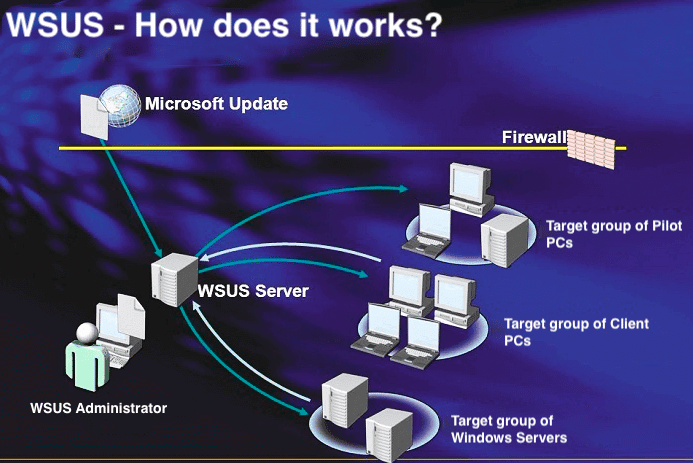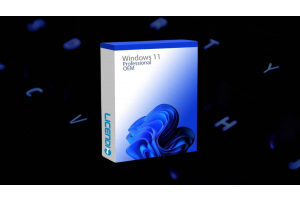What is WSUS and what is it for?
WSUS, also known as Windows Server Update Services (formerly known as SUS: Server Update Services) is a program that facilitates the dissemination of patches, updates and other releases hosted on Microsoft Update, but what is it?
This update server can be used to centrally manage, distribute and install Microsoft product updates across an enterprise IT network in a secure and reliable manner. Windows Defender, Windows 10 and Microsoft Office are just a few of the products mentioned.
How WSUS works: what is it and how does it work?
WSUS can be used on Windows Server as a service. One or more WSUS servers can be configured in an organization's IT infrastructure in response to factors such as the number of client computers (including server computers) whose updates need to be managed by WSUS.
There is flexibility to connect multiple WSUS servers to Microsoft Update if more than one is planned to be used. The WSUS servers linked to Microsoft Update can serve as an update source for the other WSUS servers in the IT infrastructure.
Upstream servers are the WSUS servers that provide updates to other WSUS servers. Since each given WSUS server can keep all other WSUS servers synchronized, only a single upstream server is needed. The number of vulnerable WSUS servers connected to the Internet is also reduced with this method.
However, bandwidth and intranet performance problems can arise if multiple downstream servers attempt to synchronize with the same upstream server at the same time. Consequently, it is necessary to take full advantage of the synchronization process to provide the best possible results.
WSUS Connection options
For more efficient distribution of updates to client PCs in different geographical regions, you can configure as many WSUS servers as needed in a multi-level hierarchical structure.
Mobile devices that only connect to the corporate IT network temporarily can be configured to automatically download updates from the nearest WSUS server if they are managed by you.
Enable and connect client machines to get updates from WSUS servers once the architecture is complete and the upstream and downstream servers are configured. As a result, once changes are available, you can examine and test them before distributing them to individual client workstations.
In addition to the categorized management of client computers and the distribution of updates based on group policies, you can create groups to control computers in a more nuanced way.
When using a WSUS server, what kind of options do you have?
The WSUS server deployment options are as follows:
1. Standalone replication modes - Windows Server update services can be configured for use with dispersed management in their default "standalone mode" configuration. It is your job to independently examine, authorize and distribute updates to client PCs connected to a WSUS server operating in this way.
2. Replica mode: this is useful for instituting a centralized management structure. By deploying WSUS in this mode, you do not have to worry about managing the servers independently. The upstream server feeds these downstream servers with new information, approval statuses and distribution guidelines.
The art of WSUS automation
WSUS allows you to automate some operations. In particular, the WSUS management console facilitates rule-based approval automation. The availability of updates, the types of assets for which updates can be accessed, and the required approval timeframe are variables that can be controlled using rules.
PowerShell scripts can also be used to schedule updates and automate the approval, cleanup and synchronization processes.
What are the advantages of WSUS?
Microsoft often releases a wide variety of updates for its products, including critical updates, security updates, drivers, service packs and tools. These updates must be installed on client workstations to fix security holes and ensure their operation.
However, manually reviewing, authorizing and deploying the changes is a time-consuming and laborious procedure. In addition, it is error-prone and could leave your IT system open to cyber threats if you have to manually ensure that all client workstations get the appropriate updates.
Windows Server Update Services allows you to streamline and automate the process of managing software updates for Microsoft products. Knowing which machines need which updates and when to deploy them is greatly simplified by this method.
Find client computers that need updates and install them at a time that does not disrupt staff work. Since WSUS servers transmit updates over the local area network, this method also helps save the company bandwidth.
If you manage a downstream server in another branch office, that server can be configured to get updates directly from Microsoft Update. This method allows you to bypass the slow connections between your headquarters and your branch offices.
Since WSUS is included in the Windows Server server role, it can be used using the licenses you currently have for that operating system without the need to purchase more.
Limitations
There are three basic limitations you may encounter when using Windows Server Update Services (WSUS):
- Only one Windows Server is capable of running WSUS. This may require a substantial investment in Windows Server licenses, depending on the size of your IT infrastructure.
- Although Windows Server Update Services (WSUS) can be used to disseminate updates for Microsoft products, its support for third-party software applications is limited and can be complicated when used to disseminate updates for those programs.
- Client computers running Linux or macOS distributions are not supported by Windows Server Update Services. This means that administration of computers running non-Windows operating systems will require the use of supplemental patch management solutions.
WSUS extensions
If you are having trouble using WSUS, you may want to look into other patch management or update management options. This approach can be used to supplement, enhance or extend the capabilities of WSUS.
You can better manage third-party updates, for example, if you use an appropriate patch management tool. Similarly, you can better monitor Windows update appointments, increase patch compliance and reporting, and control your IT infrastructure more clearly.
Do you have any questions?
If you are interested in purchasing Server or Windows computer licenses, you can find all the versions we have available in our online store. We offer the best product licenses for any type of operating system. Find more interesting information on our Youtube Channel.
If you need more help, do not hesitate to contact our customer service team.
Write us a comment or give us a call.
Best regards,
Your Licendi Team







